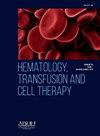来那度胺维持剂量对多发性骨髓瘤患者生存结局的影响
IF 1.6
Q3 HEMATOLOGY
引用次数: 0
摘要
目的本研究旨在评估来那度胺维持剂量对我院自体干细胞移植(ASCT)后接受维持治疗的多发性骨髓瘤(MM)患者的临床结局和来那度胺难治性发展的影响。方法回顾性分析82例行asct术后21/28天周期来那度胺维持治疗的MM患者。低剂量维持被定义为低于最大允许水平的剂量,由患者开始时的肾小球滤过率(GFR)和血液学参数决定。最大耐受剂量(MTD)被定义为基于这些标准的患者可以耐受的最高剂量。结果在整个队列中,中位PFS为56.0个月(95% CI: 40.15-71.85),中位OS未达到。然而,88.3%的患者在60个月时存活,68.2%在120个月时存活。在接受低剂量维持治疗的患者中,91%的患者有≥VGPR的反应,而在接受最大耐受剂量治疗的患者中,这一比例为73.3% (p = 0.005)。而接受低剂量维持治疗的患者中位PFS为56.0个月(95% CI 47.06-64.93);在MTD接受维持的患者中位PFS为33个月(95% CI 23.36-42.63) (p = 0.166)。17例(20.7%)患者在维持治疗期间因不良反应而减少剂量。其中,11名患者(16.9%)最初接受低剂量维持治疗,6名患者(40%)接受MTD治疗(p = 0.42)。低剂量维持治疗的中位持续时间为21个月(6-34),MTD维持治疗的中位持续时间为11个月(4-24)(p = 0.114)。40例(48.7%)出现进展的患者接受了二线治疗。中位PFS2为25.36个月(95% CI 9.24-41.48),中位OS2为73.23个月(95% CI 42.50-103.95)。来那度胺为基础的二线治疗组的中位PFS2为25.43个月(95% CI 0.20-50.66), 60个月生存率为70%,而无来那度胺治疗组的中位PFS2为25.36个月(95% CI 6.30-44.42), 60个月生存率为53.8% (p = 0.978,p = 0.902)。低剂量维持治疗后,无来那度胺治疗组的中位PFS2为26.167个月(95% CI 5.571-46.762),来那度胺二线治疗组的中位PFS2为25.433个月(95% CI 0.08-50.787) (p = 0.581)。虽然无法计算中位OS2,但在60个月时,接受来那度胺治疗的患者生存率为74.5%,而不接受来那度胺治疗的患者生存率为62.3% (p = 0.637)。结论本研究引入了低剂量与MTD来那度胺维持的概念。MTD不能带来生存益处,而且与毒性增加有关。我们的研究结果支持低剂量维持是更可取的方法,尽管来那度胺的难治性仍然值得关注。本文章由计算机程序翻译,如有差异,请以英文原文为准。
IMPACT OF LENALIDOMIDE MAINTENANCE DOSAGE ON SURVIVAL OUTCOMES IN MULTIPLE MYELOMA
Objective
This study aimed to assess the impact of lenalidomide maintenance dosing on clinical outcomes and the development of lenalidomide refractoriness in Multiple Myeloma (MM) patients who received maintenance therapy following Autologous Stem Cell Transplantation (ASCT) at our institution.
Methodology
A retrospective analysis was conducted on 82 MM patients who underwent lenalidomide maintenance therapy on a 21/28-day cycle post-ASCT. Low-dose maintenance was defined as a dose below the maximum allowable level, determined by the patient’s Glomerular Filtration Rate (GFR) and hematologic parameters at initiation. The Maximum Tolerable Dose (MTD) was defined as the highest dose a patient could tolerate based on these criteria.
Results
In the overall cohort, median PFS was 56.0-months (95% CI: 40.15‒71.85) and median OS was not reached. However, 88.3% of patients were alive at 60-months and 68.2% at 120-months. A response of ≥ VGPR was observed in 91% of patients receiving low-dose maintenance therapy, compared to 73.3% in those receiving treatment at the maximum tolerated dose (p = 0.005). While the median PFS was 56.0-months (95% CI 47.06‒64.93) in those receiving low-dose maintenance; the median PFS was 33-months (95% CI 23.36‒42.63) in those receiving maintenance at the MTD (p = 0.166). Dose reductions during maintenance therapy due to adverse effects were reported in 17 patients (20.7%). Of these, 11 patients (16.9%) were initially on low-dose maintenance, while 6 patients (40%) were on the MTD (p = 0.42). The median duration of maintenance therapy was 21 months (6–34) for patients on low-dose maintenance and 11 months (4–24) for those on the MTD (p = 0.114). Second-line treatment was administered to 40 patients (48.7%) who experienced progression. The median PFS2 was 25.36-months (95% CI 9.24–41.48), and the median OS2 was 73.23-months (95% CI 42.50–103.95). Median PFS2 was 25.43-months (95% CI 0.20‒50.66) and the survival rate was 70% at 60-months in those receiving lenalidomide-based second line therapy, while median PFS2 was 25.36-months (95% CI 6.30‒44.42) and the survival rate was 53.8% at 60-months in those receiving lenalidomide free therapy (p = 0.978, p = 0.902 respectively). Following low-dose maintenance therapy, the median PFS2 was 26.167-months (95% CI 5.571–46.762) in the lenalidomide free therapy group and 25.433-months (95% CI 0.08–50.787) in the lenalidomide-based second line therapy group (p = 0.581). Although median OS2 could not be calculated, at 60-months, the survival rate was 74.5% in patients receiving lenalidomide-based treatment, while it was 62.3% in patients receiving treatment without lenalidomide (p = 0.637).
Conclusion
This study introduces the concept of low dose versus MTD lenalidomide maintenance. MTD does not confer a survival benefit and is associated with increased toxicity. Our findings support low-dose maintenance as a preferable approach, although lenalidomide refractoriness remains a concern.
求助全文
通过发布文献求助,成功后即可免费获取论文全文。
去求助
来源期刊

Hematology, Transfusion and Cell Therapy
Multiple-
CiteScore
2.40
自引率
4.80%
发文量
1419
审稿时长
30 weeks
 求助内容:
求助内容: 应助结果提醒方式:
应助结果提醒方式:


